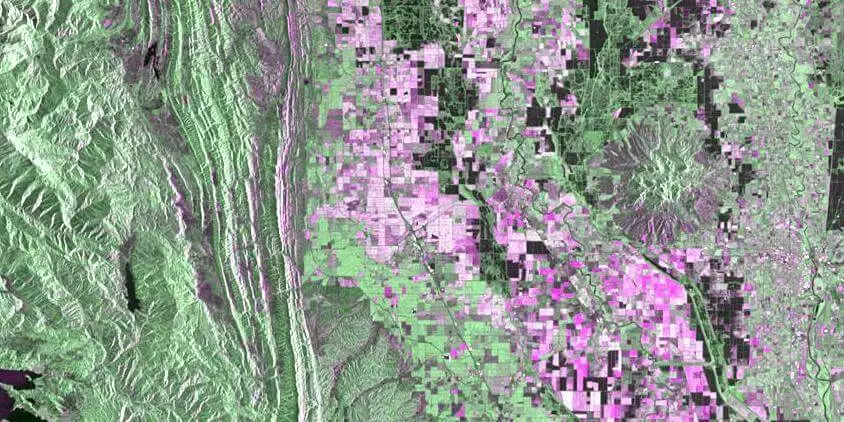
Remote Sensing: Painting A Picture Of Earth From Above
In order to learn about the properties of the objects on Earth, remote sensing (RS) uses the way that radiation interacts with those entities. One of the greatest advantages of remote sensing is the ability to collect accurate data from vast places, especially those otherwise hard-to-reach to humans (such as the ocean floor or a forest in a wildfire). This quality has led to the widespread use of remote sensing in a broad range of commercial applications, from planning cities to forest management to tracking the effects of climate change on crop production.
What Is Remote Sensing?
Remote sensing is a technique for observing and assessing the reflected and radiated energy of any object from afar, commonly with the help of airplanes and satellites. But what is the purpose of remote sensing? Briefly, it is applied to any object of study to identify and track changes in its physical characteristics.
Specially designed remote sensing cameras help scientists gain a deeper understanding of Earth by providing them with satellite images in near real-time from far away. At the same time, all of us may better assess any area of interest (AOI) and make decisions with the help of remote sensors that provide a wider view and an abundance of information. Here are just a few illustrations:
- cameras onboard remote sensing satellites and airplanes capture images of vast swaths of Earth’s surface, giving us access to details we wouldn’t otherwise have;
- ship’s sonar devices map the seafloor without the need to actually descend to the depths;
- satellite cameras capture temperature fluctuations even in remote, unreachable parts of the ocean.
Optical and radar images are the two most common forms of satellite data, and they are provided by distinct types of remote sensing. You can get a superb bird’s-eye perspective of the planet with optical satellite images. Nevertheless, optical sensors can only function during daylight since they measure reflected sun energy and cannot see through clouds. In contrast, radar sensors are capable of imaging in the daytime, nighttime, and nearly all kinds of weather. As a bonus, radar remote sensing can indicate soil moisture, submerged vegetation, water contamination, and biomass in forests and woodlands, all of which are hidden from naked sight.
If combined with other data sources, remote sensing data equips regional planners with a more complete and up-to-date picture of their areas of responsibility. Water consumption, soil moisture, pest and weed infestations, fallow lands, and urban sprawl are just a few of the factors that can be measured and monitored thanks to these advancements in technology.
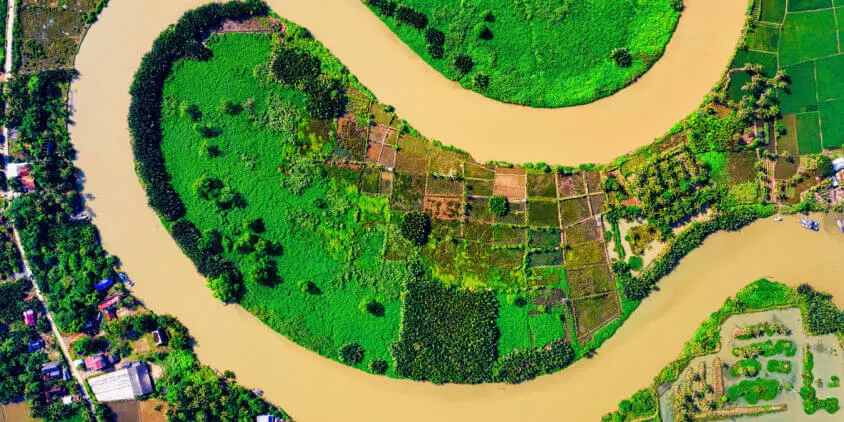
How Does Remote Sensing Work?
The amount of radiation that an object reflects is the physical basis of remote sensing. Special sensors collect information about the reflected energy, and processing facilities turn it into a format that anyone can use. This lets us learn about the object’s unique properties that we wouldn’t be able to see with the human eye.
Basic Principle Of Remote Sensing
Objects and surfaces can be recognized and distinguished based on the radiant energy emitted/reflected by them. This principle underpins remote sensing, which detects and records the radiant energy for further study.
Different objects and surfaces, like water, soil, or plants, return energy in different electromagnetic bands in different quantities. What factors actually impact this? Here are the main ones:
- properties of the object: chemical and physical composition, the kind of material, and surface roughness;
- properties of the radiation: the radiant intensity, incidence angle, and wavelength.
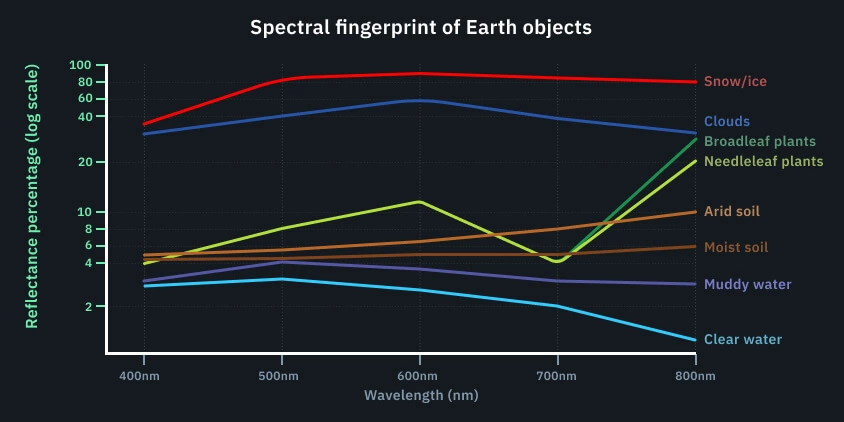
Diverse disciplines come together in remote sensing, including optical science, photography, spectroscopy, electronics, computer science, telecommunications, satellite launch technology, and more. And this is where the remote sensing system comes in, bringing together all of these individual technologies into one cohesive whole. Each of the many elements and stages in remote sensing must go off without a hitch for the process to be a success.
Elements Of Remote Sensing
Incident radiation interacts with the objects of study and is captured by the sensor. A good example of this are the imaging systems, which typically entail the elements of remote sensing listed below. Yet, it’s important to remember that remote sensing also includes non-imaging sensor types and the detection of released energy.
The following seven basic components form the backbone of remote sensing :
- Source of energy/illumination. A source of energy must be available either to illuminate the object of interest or to supply electromagnetic radiation to it.
- Radiation/energy and the atmosphere. Throughout its path from its origin to its destination, the radiation will interact with atmospheric particles. Once the energy passes from the object to the sensor, a second interaction may take place.
- Object of study. When the energy finally reaches its target, their interaction is determined by the characteristics of the radiation itself and the object.
- Radiation-recording sensor. A sensor that is physically apart from the object of study must pick up the electromagnetic radiation the target emits or reflects.
- Data processing facility. The sensor’s readings must be sent (usually electronically) to a data receiving and processing facility, where the measured energy is translated into a usable image.
- Analysis and interpretation. Following data processing in remote sensing, users visually and/or digitally analyze and interpret satellite images to acquire information about the object of study.
- Practical use. Lastly, the process involves putting the information we’ve learned from the images to good use to gain a deeper understanding of the target, uncover previously unknown facts, or aid in issue-solving.
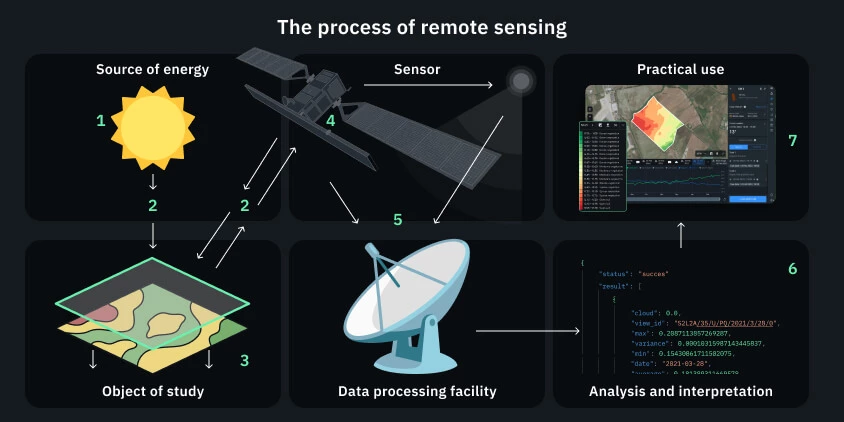
Advantages And Disadvantages Of Remote Sensing: How Do They Compare?
Like any other method of data collection and analysis, remote sensing has its benefits and limitations. Let’s take a closer look at them to help you decide if you need satellite-based remote sensing and how your business can benefit from it.
Among the many advantages of remote sensing are:
- Coverage of vast regions, with the added benefit of repeatability, has made this technology invaluable for regional studies and change detection in fields, forests, waterbodies, etc.
- Remote sensing has simplified data acquisition at various scales and resolutions.
- Low- to medium-resolution satellite images are often accessed for free or for a small fee.
- The color composite remote sensing images provide much more accurate representations of the underlying landscape than a single-band image or photo from an aircraft.
- Remote sensing data is simple for computers to process and interpret for various practical applications.
- As satellite-collected data can be provided in many different forms, it is easy to integrate it with other data sets to make more informed decisions.
Limitations of remote sensing include:
- When used for the detailed study of small areas, advanced remote sensing can be quite costly.
- Radars and lidar, so as other active remote sensing systems send out electromagnetic radiation, which can interfere with the object of study. Yet, they can often be replaced with non-intrusive optical alternatives. One example is the EOS SAT constellation, whose first optical remote sensing satellite, EOS SAT-1, is now monitoring agricultural and forestry targets.
- While analyzing an image, it is important to keep in mind that it may be affected by factors other than the ones being measured.
- There is a risk of misclassification if distinct phenomena under examination appear to be the same. For this reason, expert assistance is needed for accurate picture analysis.
- To use remote sensing tools correctly, you need to get special training, which makes them more expensive in the long run. But if you outsource your data analysis needs to an imagery processing platform, such as EOSDA LandViewer, you may do so for little to no cost.
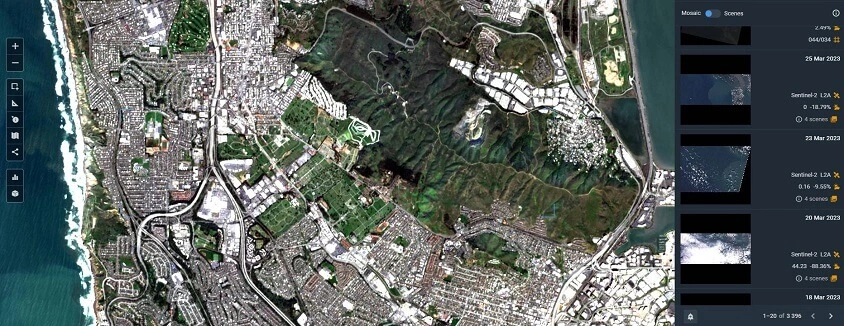
EOSDA LandViewer
Access historical satellite imagery with global coverage for free, analyze them on-the-fly and download.
Applications Of Remote Sensing
Using platforms that provide processed images is the most time-efficient method of accessing remote sensing data. This reduces the learning curve for understanding this data and the time and money spent on consulting outside sources. Platforms like these may have a narrower focus, such as providing images for the agricultural sector, or might serve a broader purpose. Let’s find out exactly: what is remote sensing used for?
Agriculture
Given the challenges facing modern agriculture, there is a pressing need to track crops’ growth and development at different scales and resolutions. The world’s food system requires near-real-time monitoring so that it may better adjust to global warming and extreme weather . Some of the most common uses for remote sensing in agriculture include:
- Raising the bar for agricultural precision. By monitoring crop growth using data from satellites, precision agriculture platforms help farmers optimize their use of fertilizer and other inputs and reduce waste.
- Measuring the soil and crop water content. Soil moisture is measured from space via satellite remote sensors. Studies of the hydrologic cycle, drought, flooding, and meteorological processes, among others, rely on estimates of soil moisture content. Remote sensing is useful not only for estimating how much water is in the soil but also for measuring how much water is in crops.
- Predicting crop yields. Potential crop yields can be estimated using remote sensing data based on current weather and soil conditions. With the help of specially developed crop yield prediction models and algorithms, growers can forecast how much harvest they will get from a given plot in a given growing season.
- Damage assessment and crop development monitoring. With the help of remote sensing technology, farmers can see exactly how far their crops have been affected by injury or stress and at what stage of growth the remaining crop is. Insurers often employ the red and infrared channels of Landsat to evaluate vegetation growth and conduct crop damage assessments on individual fields. It is possible to use this information to verify the existence of planted crops and check up on crop insurance claims. EOSDA Landviewer now has several infrared band combinations to help with this.
- Identifying crops. If the type of crop being investigated is peculiar or shows unusual traits, remote sensing tools can help identify it. Fast crop classification across large areas is now possible thanks to space-based crop research.
- Monitoring droughts. Using remote sensing to study weather in agriculture is crucial, especially when looking at drought patterns in rural and farming areas. Assessing how much time has passed since the last rainfall and how long it will be before the next one is useful for tracking and predicting drought.
- Assessment of crop condition and identification of crop stress. The health of crops can be remotely monitored with the help of satellite imaging and Normalized Difference Vegetation Index (NDVI) technology. In the NDVI maps, green indicates healthy crop fields, whereas red or blue indicate problem areas. The use of RS technologies is crucial for evaluating the overall health of a crop and its resilience in the face of adverse conditions, such as heat stress. With this information, you can get a good idea of the harvest’s overall success.

Forestry
As more and more remote sensing images and products enter the market, miscommunication between RS experts and forestry professionals is becoming less of an issue. Now, foresters and ecologists may now quickly and accurately obtain important data like the leaf area index, vegetation density, and land use . Other applications of remote sensing in the forest management include:
- Assessing forest supplies. Forests supply essential materials for construction, packaging, paper production, and many other industries, hence monitoring changes in forest cover by remote sensing is common practice.
- Forest monitoring. With the help of this technology, forest cover, plant life, and deforestation rates can all be tracked in real time.
- Controlling wildfires. Infrared sensors on satellites can spot the first signs of a fire within minutes . This allows fire crews to be dispatched to the right places at the right times, reducing the damage caused by forest fires.
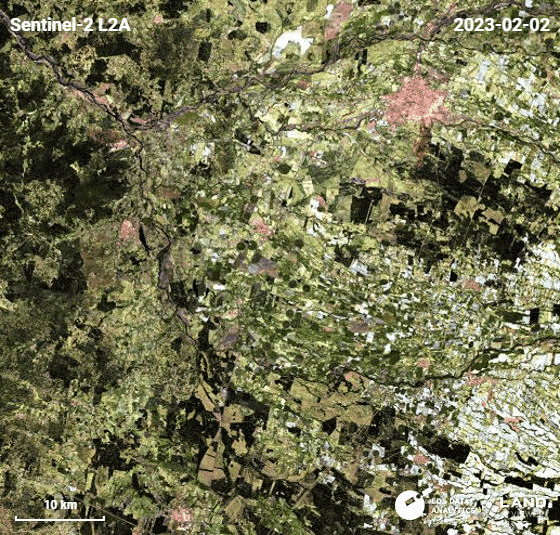
Urban Planning
Rapid urbanization in many parts of the world has increased the need for up-to-date topographic and land-use maps. Numerous urban planning initiatives use remote sensing because it offers the most accurate data possible over expansive areas. Furthermore, remote sensing can be used in urban planning for:
- Assessing the state of rural roads. Remote sensing techniques have advanced to the point that they can now be used to examine the state of rural roads within an inch of accuracy. It’s a huge money and time saver for transporters.
- Identifying terrain types and land uses. It is possible to learn both the land’s physical characteristics and its current use by applying remote sensing technologies.
Climate Change
We can now monitor any climate-related event or process, such as changes in carbon stock or El Niño climate pattern in the Pacific Ocean , thanks to remote sensing, which monitors land, seas, and atmosphere at a variety of temporal and spatial resolutions. The following are some of the most typical applications of remote sensing in climate change research:
- Climate change observations. CERES, MODIS, and Sentinel are just some of the satellites that have made it feasible to monitor climate change from orbit, allowing us to compare past and present climate events. To further its mission of empowering a more sustainable future, the very first Earth-orbiting satellite in the EOSDA constellation will also collect accurate weather data using its several spectral bands.
- Management of natural resources. Today we can keep an eye on land use, locate wetland areas, and watch for deforestation. With this information at hand, we can focus our conservation efforts and discover solutions to the environmental problems brought on by increasing urbanization and human activity.
Disaster Management
As satellites routinely capture precise, consistent, and up-to-date data across vast areas throughout the world, remote sensing is often the sole means to see what is going on at the site where a disaster hits. In particular, remote sensing in disaster management is handy for:
- Monitoring landslides. Examples of remote sensing techniques in this field include landslide detection and mapping, and trigger component analysis. As the spatial and temporal resolution of satellite images gets better, they become more useful for predicting and monitoring landslides .
- Hazard assessment. Keeping a close watch on weather-related disasters like hurricanes, earthquakes, and floods is essential. Pre- and post-disaster preparedness plans can be better informed by remote sensing data analysis.
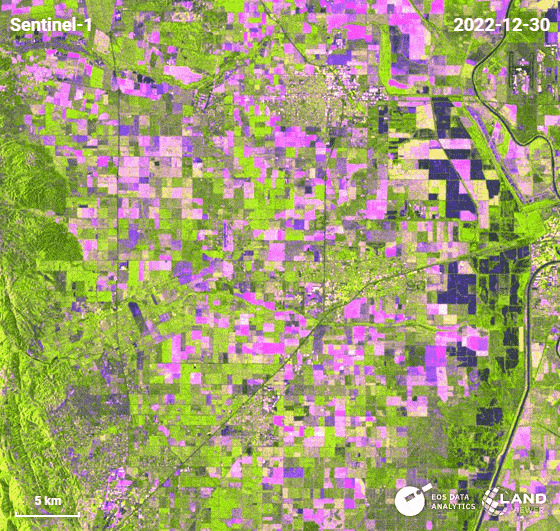
Combining Remote Sensing And GIS
The data used in geographic information systems (GIS) comes primarily from remote sensing. Land use patterns, maps of vegetation cover, and resource distribution are just some of the insights that can be gleaned from analyzing remote sensing data using GIS software. Furthermore, GIS may be used to verify RS data, increasing confidence in the accuracy of the information obtained from such data.
The combination of GIS and remote sensing has benefited a lot of different areas, such as farming, forestry, urban planning, environmental study, and natural resource management. Better resource allocation and ecological management are just two outcomes of better analysis and interpretation of spatial data.
If you only want to use GIS to analyze remote sensing data, check out EOSDA Landviewer. It’s a breeze to combine the platform with other GIS software. The best way to incorporate EOSDA LandViewer data into another online GIS tool is through the WMS (Web Map Service). Both historical and most recent satellite images are readily available through EOSDA LandViewer. You can download the image you need and then analyze it with any common software package. Meanwhile, if you’re looking for a powerful GIS tool for managing agricultural or forest resources, consider our specially designed solutions, EOSDA Crop Monitoring and EOSDA LandViewer.
Why remote sensing is important is no longer a question. Every day, people all over the world employ remote sensing to gain insight into the planet in ways that were previously impossible. The expansion of national and commercial satellites provides improved coverage and more consistent data collection for remote sensing applications across many sectors. This way, people can lessen the damage caused by natural disasters and find lasting solutions to many of the world’s most critical problems.
About the author:
Kateryna Sergieieva has a Ph.D. in information technologies and 15 years of experience in remote sensing. She is a Senior Scientist at EOSDA responsible for developing technologies for satellite monitoring and surface feature change detection. Kateryna is an author of over 60 scientific publications.
Recent articles

Analyze 2025 & Plan Your Best Year Yet: LandViewer Christmas Offer
It’s the most wonderful time of the year! The Christmas holidays are here, and so is your chance to analyze 2025 and plan a prosperous 2026 with more affordable Pro plans in LandViewer.

EOSDA Models Climate Change Impact On Sugarcane Yields
EOSDA modeled future temperature, rainfall, and other climate impacts on Veracruz sugarcane. The results help growers plan long-term adaptation strategies, including timing, varieties, and irrigation.

EOSDA LandViewer Black Friday Sale: Exclusive Offers & Giveaway
This Black Friday, LandViewer offers new users the chance to save on monthly plans, get extra months with yearly subscriptions, and participate in a free annual plan giveaway.

